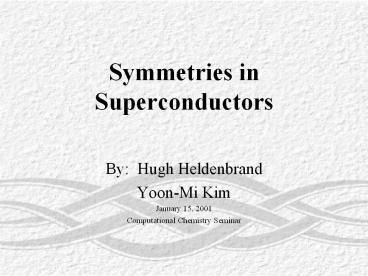Symmetries in Superconductors - PowerPoint PPT Presentation
Title:
Symmetries in Superconductors
Description:
How can the different symmetries of a crystal be used to describe it? Introduction ... State University of New York at Binghamton: Preparation, Structure and ... – PowerPoint PPT presentation
Number of Views:55
Avg rating:3.0/5.0
Title: Symmetries in Superconductors
1
Symmetries in Superconductors
- By Hugh Heldenbrand
- Yoon-Mi Kim
- January 15, 2001
- Computational Chemistry Seminar
2
Problem Statement
- How can the different symmetries of a crystal be
used to describe it?
3
Introduction
- Superconductors.
- State University of New York at Binghamton
Preparation, Structure and Properties of a
High-temperature Superconductor (YBa2Cu3O7). - Model the system using CAChe software . . .
(Observations and Questions). - MacSpartan vs. CAChe (demo version)
4
Computational Method
- Our program was CAChe, the happy union on
computational chemistry and highly sophisticated
graphics. (CAChe 4.1 A Chemists Guide) - When we went to enter the space group and
fractional coordinates for YBa2Cu3O7 we got an
error message that we thought was related to the
fact that we were using demo version software.
5
(No Transcript)
6
(No Transcript)
7
Computational Method
- This is the point where the computer would say
path not found for space groups.
8
(No Transcript)
9
Point Group Symmetries
- There are four main types of symmetry operations
- Rotation (Cn)--the object appears identical if
rotated about an axis by a 360/n 2p/n
degrees. - Improper Rotation (Sn)a combination of a
rotation and a mirror plane reflection
perpendicular to the axis of rotation.
10
Point Group Symmetries
- Inversion (center of symmetry, i)--each point in
the object is converted to an identical point by
projecting through a common center and extending
an equal distance beyond this center. - Reflection (mirror plane,?)--each point in the
object is converted to an identical point by
projecting through a mirror plane and extending
an equal distance beyond this plane.
11
(No Transcript)
12
(No Transcript)
13
Space-Group Symmetries
- 230 space groups
- The International Union of Crystallography
publishes them in Volume A of International
Tables for Crystallography.
14
The Herman-Mauguin System
- The space group of YBa2Cu3O7 is
- P mmm, a 3.820, b3.886, c11.683
15
Herman-Mauguin System
- The first letter identifies the centering of the
lattice - P Primitive
- I Body centered
- F Face centered
- C C-centered
- B B-centered
- A A-centered
- Our crystal is P, so it has a primitive Bravais
lattice (there are no atoms outside the eight
that make up the corners).
16
Herman-Mauguin System
- The mmm in the space group for YBa2Cu3O7 means
that it has three mirror plane transitions. - A mirror plane is simply a plane through which
the crystal can be reflected identically on both
sides.
17
Herman-Mauguin System
- The a 3.820, b3.886, c11.683 in the space
group gives the dimensions of the crystal. - Since a, b, and c are all different numbers, the
crystal is orthorhombic.
18
Database of Superconductors
- Here is a website with 3-D models of
superconductors, which could be produced with a
program like CAChe. - http//barns.ill.fr/dif/xtal-3d.super.html
19
Conclusion
- Why does a crystals symmetry matter?
20
Bibliography
- http//www.chem.ox.ac.uk/icl/heyes/structure_of_so
lids/Lecture4/Lec4.html - http//imr.chem.binghamton.edu/labs/super/superc.h
tml - http//barns.ill.fr/dif/xtal-3d.super.html
- Huheey, James et al. Inorganic Chemistry
Principle of Structure and Reactivity. New York
Harper Collins, 1993.































